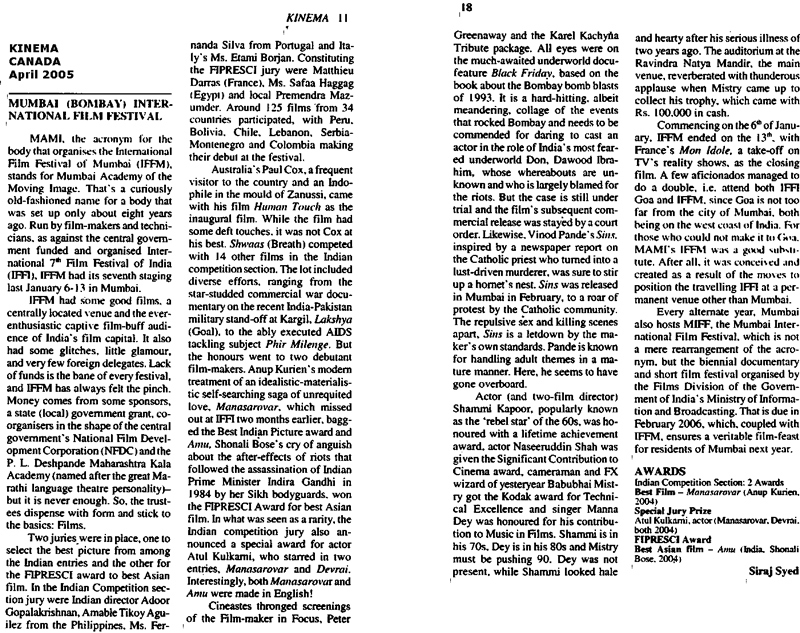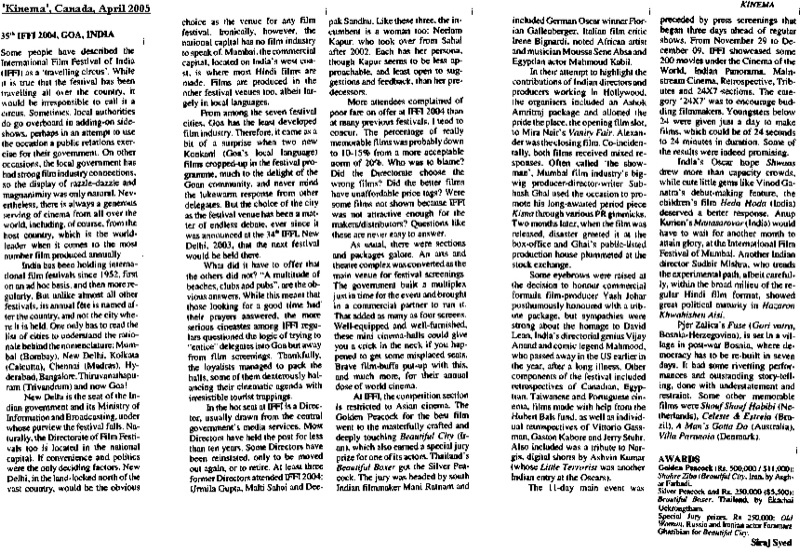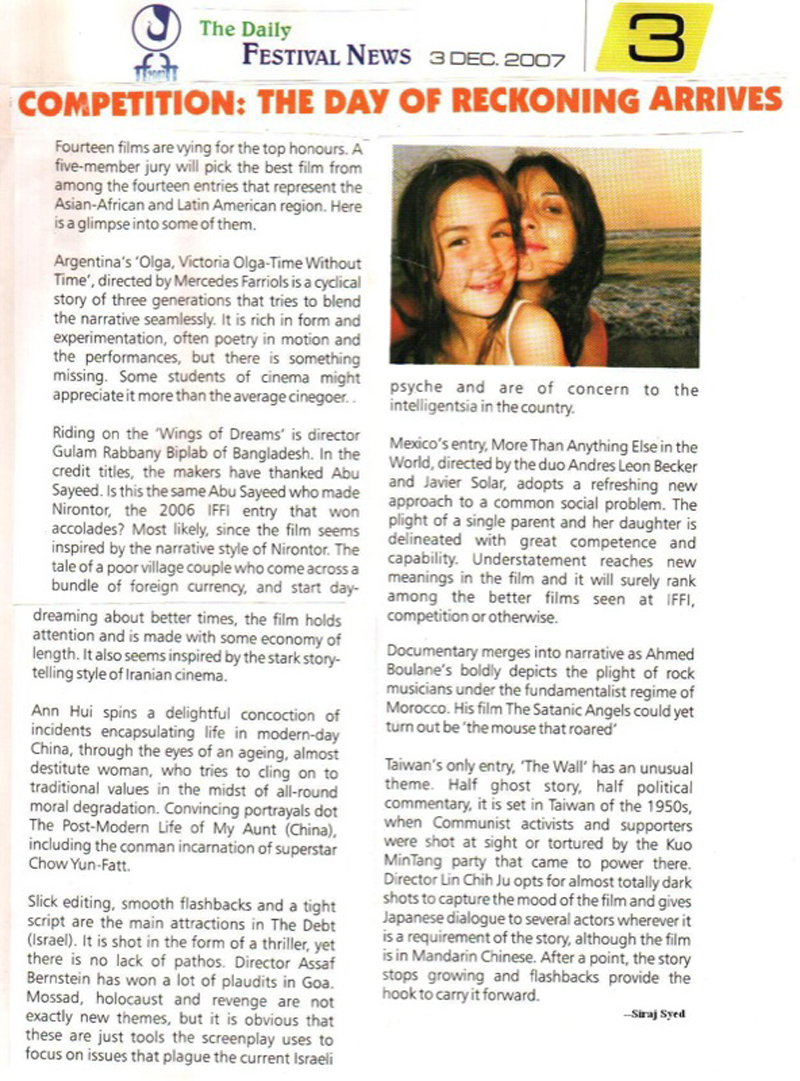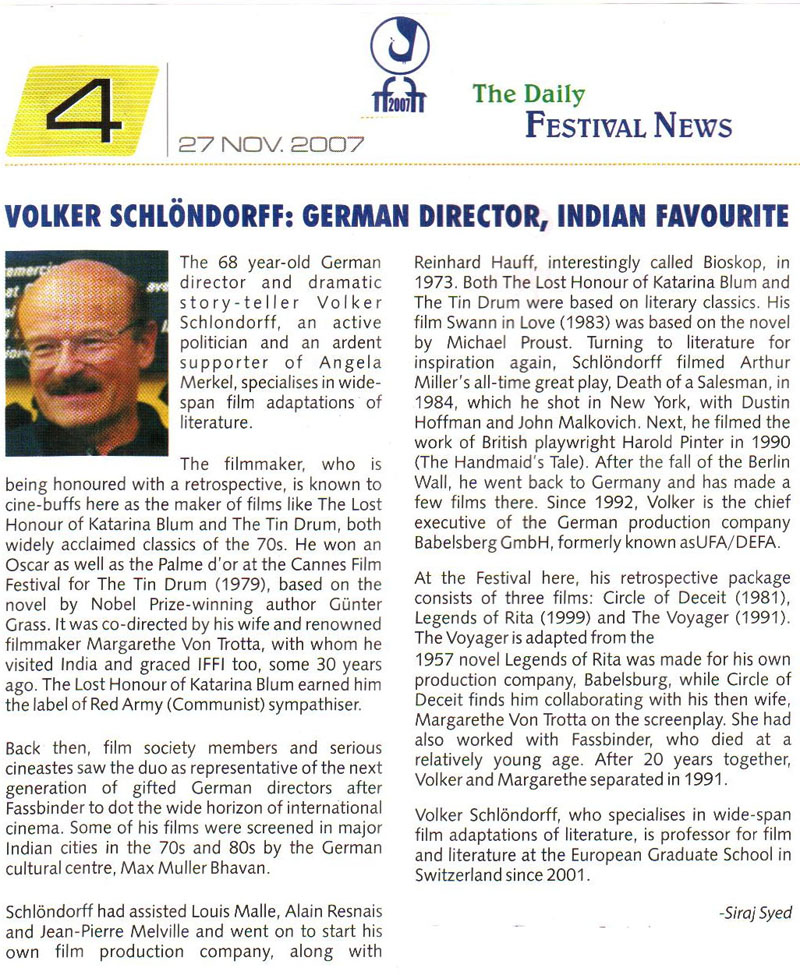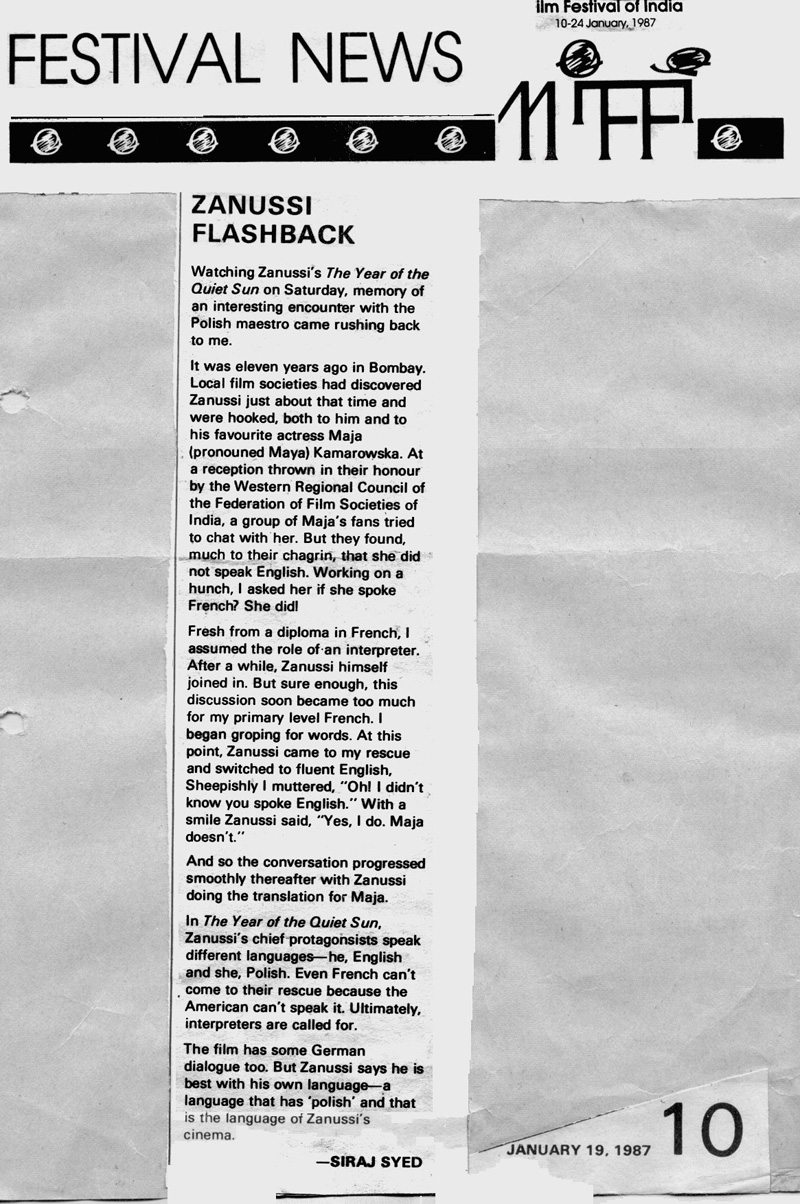|
|
||
|
Pro Tools
FILMFESTIVALS | 24/7 world wide coverageWelcome ! Enjoy the best of both worlds: Film & Festival News, exploring the best of the film festivals community. Launched in 1995, relentlessly connecting films to festivals, documenting and promoting festivals worldwide. Sorry for the interruption, we needed to correct and upgrade some modules. Working on a new website. For collaboration, editorial contributions, or publicity, please send us an email here. You need for put your full detail information if you want to be considered seriously. Thanks for understanding. User login |
Siraj SyedSiraj Syed is the India Correspondent for FilmFestivals.com and a member of FIPRESCI, the International Federation of Film Critics. He is a Film Festival Correspondent since 1976, Film-critic since 1969 and a Feature-writer since 1970. He is also an acting and dialogue coach. @SirajHSyed  Siraj Syed reviews Allied: Two Allies, Both Spies, One Cries, One Dies
Siraj Syed reviews Allied: Two Allies, Both Spies, One Cries, One Dies There are a few things to like about Allied. Then there are a few things you don’t like so much. At the end f the report card, you might end up with as many –ves as you mark +ves, which doesn’t get you anywhere, really. Brad Pitt’s third war movie in a row and Marion Cotillard’s sequence of big projects promises you CasaBlanca, but gives you Morocco instead. Almost everything in the film is conceived and executed as a binary, perhaps to justify its real premise, “Make love, not war”—Steven Knight, who wrote the film. Love and war are binaries too. In 1942 during World War II, Royal Canadian Air Force intelligence officer Max Vatan, under the Allied command, travels to Casablanca in French Morocco to assassinate the German ambassador in CasaBlanca. He is partnered with a French Resistance fighter named Marianne Beausejour, who had escaped from France after her resistance group was compromised and killed. The two pose as a married couple, and, against all professional codes, grow close, despite agreeing that in their line of work, feelings can get people killed. Marianne, who is trusted by the Germans, secures Max an invitation to the party where they plan to conduct the assassination. The mission goes well, and they both escape. Max asks Marianne to come with him to London, and be his wife. The two get married, settle down in Hampstead, and have a baby girl, who they name Anna. A year later, Max learns from the Special Operations Executive that Marianne is suspected of being a German spy, having adopted her identity after the real Marianne was killed in France. In order to test their suspicions, SOEs run a 'blue dye' operation: Max is ordered to write down a piece of false intelligence at home, where Marianne can find it. If the information is picked up from intercepted German transmissions, Max must personally execute her, or be hanged for treason. Is it a true story, or is it? Don’t waste your time trying to crack this one. Even f it is true, it is third hand, and there is no way anyone can verify it this way or the other. In August 2015, Steven Knight comes with good, if not outstanding credentials--Hundred-Foot Journey, directed by Lasse Hallström, based on the book of the same name by Richard C. Morais, starring Helen Mirren; Seventh Son, an adventure story starring Jeff Bridges, Julianne Moore, Djimon Hounsou, Kit Harington and Jason Scott Lee; Pawn Sacrifice, a biopic on the chess champion Bobby Fischer, with Tobey Maguire playing Fischer in the film. This is what he told a publication: “I was twenty-one years old and bumming around America with my girl-friend, after finishing college. We were in Texas, and her auntie, who we were staying with for a while, told me this story of her brother, who was an SOE (Special Operations Executive) agent behind enemy lines who fell in love with what he believed to be a French Resistance agent, a former school-teacher. She became pregnant, he brought her home against normal procedure, and one year later he reported to work one morning, to be told by a superior officer that they knew she was working for the Germans and that he had to go home and shoot her. And he did.” Steven gives nods to CasaBlanca and Graham Greene, much more to GG than I found anywhere, in the narrative, which pitches marriage against patriotic duty. It is a much more existential question with Greene than it is with Knight, who treads on moral territory and the value of individual life over the madness called war. Incidentally, Max is shown reading a Greene novel in one of the shots. “Show me your chickens, Max,” is a line that puts the seal on the CasaBlanca homage, as if the entire first half being set in the city was not enough. Remember Hummingbird? That was a film that Knight wrote and directed, and guess what is the identification sign in the hotel resto-bar that leads Vatan to Marianne? Hummingbird! I could never get the name Vatan while watching the film, but one thing is for sure—it is not Arabic/Persian/Urdu/Hindi word Vatan; rather, it is of Greek/Romanian origin, coming from Vatanadis. Since 1972, movies made by Robert Zemeckis might be rewritten at an early stage, as was the case here, though the basic premise was not touched. Zemeckis himself has this to say, on his way of working, “They (my films) change in the editing room, but I don’t rearrange the story. I’m a very meticulous film-maker. I shoot exactly what I need. I don’t shoot a bunch of stuff and then try to build the movie afterward. I don’t want to shoot any more than I absolutely have to.” That approach got us Romancing the Stone, Back to the Future, Who Framed Roger Rabbit and Forrest Gump. Allied too is not over-directed. But over-written, it is. You are told almost everything, literally, and then shown the same, visually. Zemeckis takes the roll back to shooting styles of the 40s too literally, both in shot-taking and cinematography. For a man who pioneered Special Effects and Visual Effects, he has employed them minimally in this film, but interestingly, in scenes like a deck of cards being shuffled in the card-sharper technique. Both Zemeckis and Knight are guilty of being impressed with Inglourious Basterds and carrying the hangover to two full scenes—one in which Pitt murders a Christoph Waltz inspired German and another, a ding-dong battle of wits in the German Consulate. When it comes to recreating and grafting a Mata Hari (WWI exotic dancer/spy) on to a WWII episode, they don’t have to look beyond Greta Garbo, Marlene Dietrich and Fassbinder’s Lili Marleen (1981). If Cotillard can’t pull it off in 2016, who can? With Pitt, Zemeckis knocks off several years (he’s 53) from his face, making it look more like a mask than a real countenance. Brad Pitt deserves some sympathy. Why air-drop an air-force officer to kill a diplomat in a foreign country with a machine gun? Why put him through the cute but indulgent routine of roof-top rendezvous and the nuances of Parisienne French vis-à-vis French spoken in the Quebec province of Canada? Whatever happened to his family and his back-story? Why the only thing he has for a family is a sister who is, most of the time, seducing her girl-friend cello player? Why let Cotillard drive him into the desert and seduce him in the middle of a sand-storm? On second thought, maybe the sympathy is mis-placed, because Pitt is a producer of the film, and Zemeckis is no spring chicken. Maybe both got their bearings a little askew. At 41, Marion Cotillard, the French singer/actress (Taxi, La vie en rose, Inception, Contagion, Assassin’s Creed) gives hints of pretension, while the dialogue first asserts and then reasserts that she ‘makes it because she fakes it realistically! Her French is, as should be, Ooh là là! Her physics and chemistry with Pitt? High marks in physics. Chemistry? She sat out. Jared Harris as Frank Heslop (The Curious case of Benjamin Button, Sherlock Holmes, Lincoln, The Man from U.N.C.L.E.) is a bit over the top. Matthew Goode as Guy Sangster (The Imitation Game, Stoker, Watchmen) comes across more scary than pitiable. Lizzy Caplan, as Bridget Vatan (The Interview, The Night Before, Now You See Me 2), has a uni-dimensional role. Anton Lesser as Emmanuel Lombard is talented, with little opportunity to show it. August Diehl as the Ambassador’s aide Hobar (Inglourious Basterds, Salt, The Counterfeiters) enjoys the formulaic phosphate. Marion Bailey (Meantime, All or Nothing, Vera Drake, Mr. Turner), as Mrs. Sinclair, is competent, though we guess her secret a little before it is revealed. Simon McBurney as S.O.E. Official (Harry Potter, Tinker Tailor Soldier Spy, Mission Impossible, The Conjuring 2) does the routine with élan. Daniel Betts as George Kavanagh, the young pilot, is the bundle of nerves he is supposed to be. Thierry Frémont (Djihad, The Round Up, Djinns), as Paul Delamare, impresses in a stock role, with the unusual twist that goes with it. Music by Alan Silvestri is appealing. Cinematography Don Burgess is guilty of letting cut-outs and back-ground painting of sets seep through. Some exteriors and facades in CasaBlanca look fake, as does the crashed plane. (Scenes set in Casablanca were shot in Gran Canaria, Canary Islands). Edited by Mick Audsley and Jeremiah O' Driscoll at an uneven pace, the film fluctuates between a World War II spy adventure and a doomed romance. After all, when a child is born during an air-raid (very fluid camera-work), can the contrast be more earth shattering? India’s Central Board of Film Certification has imposed several drastic cuts on the film in return for granting it the U/A certificate, which allows those above 18 to see the film, if accompanied by adults. As a result, you will see more sand in Operation Desert Storm than skin. On a scale of * to *****, the film deserved more than what it gets. You can see the pitfalls it has run into...from the True Story to a Screenplay to Marketable Action and Tears rewrite to a Star Cast Heavy Narrative, to an Unsure, Thinly but Widely Spread, Tentative Tale. Most viewers might find the compositions archaic and the VFX primitive. Judge it objectively, and you might come away with more than you expected. Rating: ** ½ Trailer: https://www.youtube.com/watch?v=Jlp94-C31cY
05.01.2017 | Siraj Syed's blog Cat. : Allies Anton Lesser August Diehl Bradd Pitt Fassbinder formula of phosphate Greta Garbo Jared Harris LIlli Marleen Lizzy Caplan Marion Bailey Marion Cotillard MarlenenDietrich Matthew Goode quebecois Robert Zemeckis Simon McBurney Steven Knight Vatan World war I World War II Hollywood
|
LinksThe Bulletin Board > The Bulletin Board Blog Following News Interview with EFM (Berlin) Director
Interview with IFTA Chairman (AFM)
Interview with Cannes Marche du Film Director
Filmfestivals.com dailies live coverage from > Live from India
Useful links for the indies: > Big files transfer
+ SUBSCRIBE to the weekly Newsletter DealsUser imagesAbout Siraj Syed Syed Siraj Syed Siraj (Siraj Associates) Siraj Syed is a film-critic since 1970 and a Former President of the Freelance Film Journalists' Combine of India.He is the India Correspondent of FilmFestivals.com and a member of FIPRESCI, the international Federation of Film Critics, Munich, GermanySiraj Syed has contributed over 1,015 articles on cinema, international film festivals, conventions, exhibitions, etc., most recently, at IFFI (Goa), MIFF (Mumbai), MFF/MAMI (Mumbai) and CommunicAsia (Singapore). He often edits film festival daily bulletins.He is also an actor and a dubbing artiste. Further, he has been teaching media, acting and dubbing at over 30 institutes in India and Singapore, since 1984.View my profile Send me a message The Editor |


















